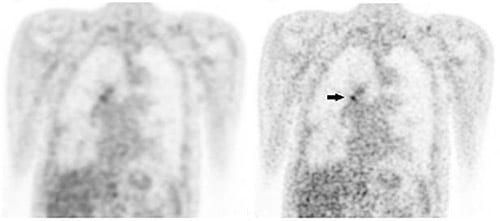A major challenge of F18-fluorodeoxyglucose positron emission tomography (FDG-PET) is detecting small lesions of less than 5-10 mm and measuring their correct uptake value. These issues can hamper therapy decision making and follow-up. A recent study¹ at Isala Hospital shows that physicians using a system with time-of-flight technology prefer the small 2 mm voxel image reconstruction, such as available on the Philips Ingenuity TF PET/CT system, for small lesion detection with FDG-PET. This material is not for distribution/use in the USA

Partnership to improve care
Isala is one of the largest non-academic hospitals in The Netherlands that offers basic care as well as top-level care in cardiology, oncology, and various other fields. The hospital recently entered a collaborative partnership with Philips to further improve its care. A key reason for choosing Philips was having access to the latest research and technologies for their clinical imaging programs. As part of this agreement, the Nuclear Medicine department has been using a Philips Ingenuity TF PET/CT system for almost two years. The Nuclear Medicine department at Isala performs about 14 PET/CT exams a day, and handles many lung cancer patients.
Sharper images with profound increase in SUV and SNR for small lesion detection
Conventional PET/CT technologies have limited spatial resolution and relatively large image voxels (around 4 mm) which increase the impact of the partial volume effect (PVE) in PET images containing small lesions. One approach for imaging small lesions is to increase the image contrast (meaning increasing the signal to noise ratio) as well as increase the spatial resolution of images by using smaller voxels for the image reconstruction. Philips Ingenuity TF time-of-flight technology provides enhanced lesion contrast and small voxel reconstruction that improves spatial resolution to support assessment of small lesions.
Improving diagnostic confidence and cutting the wait list
The Nuclear Medicine department chose this system to improve the diagnostic confidence of their FDG-PET scans and to shorten its growing wait list. The Ingenuity TF delivers high resolution reconstructions of 2 mm voxels very quickly compared to conventional PET/CT technologies thanks to its proven TOF technology. This is possible because TOF improves contrast by up to 30% compared to non-TOF systems and improves the signal-to-noise ratio, resulting in exceptional image quality, increased speed, and enhanced accuracy. A whole body scan with a 2 mm high resolution reconstruction can now be done much faster compared to scans of smaller areas on their previous system. The exams per day are now steadily increasing.
Study points out physician preference for 2 mm voxel image reconstruction in detecting small lesions
A recent study, carried out by clinicians at Isala and published in the Journal of Nuclear Medicine Technology, showed physician preference for using the 2 mm voxel reconstructions on the Ingenuity TF PET/CT system to detect small lesions in FDG-PET exams. In the study, FDG PET scans of two image-quality phantoms (sphere sizes 4-37 mm) and 39 consecutive patients with lung cancer were analyzed. The authors found a profound increase in SUV and signal-to-noise ratios (SNRs) for small lesions using a small 2 mm voxel reconstruction. See results in table below.

The physicians in the study preferred the small voxel reconstructions in 76% of the cases.

Figure 1: F18-FDG PET images using standard voxel reconstruction (A) and small voxel reconstruction (B). The lesion in the left lung (volume 0.68 mL) with a SUVmax of 2.6 using the standard voxel reconstruction, increased by 54% to 4.0 using the small voxel reconstruction. The SNRmax increased by 115% (from 3.1 to 6.6). The ROIs used for background measurements are illustrated by the black circles.

Figure 2: F18-FDG Pet images with standard voxel reconstruction (A) and small voxel reconstruction (B). The SUVmax of the lesion in the right hilar region (volume 0.50 mL) with a SUVmax of 3.0 using the standard voxel reconstruction, increased by 45% to 4.4 on the small voxel reconstruction (black arrow). The SNRmax increased by 77% (from 9.8 to 13.3).
Case study of metastatic adrenal gland
Clinicians at Isala also recently published a case study² that reported results from a scan of a 68 year-old woman suspected of lung cancer, who underwent a whole body FDG-PET scan.

Figure 1: The 4 mm voxel reconstruction shows no enlargement of the gland in CT and a slightly increased FDG uptake. The gland was considered benign and combined chemotherapy was initiated.

Figure 1: The 2 mm voxel reconstruction showed a higher SUVmax and a higher contrast despite increased noise. The gland was considered suspicious and more likely to be metastatic.
Written by:
Dr. Maryam Khodaverdi Clinical Scientist Advanced Molecular Imaging (AMI) Philips Healthcare Benelux
Share this article
¹⋅Koopman D, van Dalen JA, Lagerweij MCM., Arkies H, de Boer J, Oostdijk AHJ, Slump CH, Jager PL. Improving the detection of small lesions using a state-of-the-art time-of-flight PET/CT system and small voxel reconstruction (2015). Journal of Nuclear Medicine Technology, 43(1). ²⋅Koopman D, van Dalen JA, Arkies H, de Boer J, Oostdijk AHJ, Slump CH, Jager PL. Improving the detection of small lesions with FDG-PET using a small voxel reconstruction. (2014). Tijdschrift voor nucleaire geneeskunde. 36(3).



